[English] 日本語
 Yorodumi
Yorodumi- PDB-2m03: Solution structure of BCL-xL determined with selective isotope la... -
+ Open data
Open data
- Basic information
Basic information
| Entry | Database: PDB / ID: 2m03 | ||||||
|---|---|---|---|---|---|---|---|
| Title | Solution structure of BCL-xL determined with selective isotope labelling of I,L,V sidechains | ||||||
 Components Components | Bcl-2-like protein 1 | ||||||
 Keywords Keywords | APOPTOSIS / BCL-xL / PUMA | ||||||
| Function / homology |  Function and homology information Function and homology informationapoptotic process in bone marrow cell / The NLRP1 inflammasome / dendritic cell apoptotic process / dendritic cell proliferation / positive regulation of mononuclear cell proliferation / SARS-CoV-1-mediated effects on programmed cell death / BH3-only proteins associate with and inactivate anti-apoptotic BCL-2 members / negative regulation of dendritic cell apoptotic process / negative regulation of intrinsic apoptotic signaling pathway in response to DNA damage / negative regulation of mitochondrial outer membrane permeabilization involved in apoptotic signaling pathway ...apoptotic process in bone marrow cell / The NLRP1 inflammasome / dendritic cell apoptotic process / dendritic cell proliferation / positive regulation of mononuclear cell proliferation / SARS-CoV-1-mediated effects on programmed cell death / BH3-only proteins associate with and inactivate anti-apoptotic BCL-2 members / negative regulation of dendritic cell apoptotic process / negative regulation of intrinsic apoptotic signaling pathway in response to DNA damage / negative regulation of mitochondrial outer membrane permeabilization involved in apoptotic signaling pathway / regulation of mitochondrial membrane permeability / negative regulation of execution phase of apoptosis / fertilization / regulation of growth / Bcl-2 family protein complex / NFE2L2 regulating tumorigenic genes / response to cycloheximide / STAT5 activation downstream of FLT3 ITD mutants / hepatocyte apoptotic process / negative regulation of release of cytochrome c from mitochondria / cellular response to alkaloid / negative regulation of intrinsic apoptotic signaling pathway / germ cell development / apoptotic mitochondrial changes / negative regulation of reproductive process / negative regulation of developmental process / BH3 domain binding / negative regulation of anoikis / negative regulation of extrinsic apoptotic signaling pathway in absence of ligand / negative regulation of protein localization to plasma membrane / ectopic germ cell programmed cell death / negative regulation of endoplasmic reticulum stress-induced intrinsic apoptotic signaling pathway / negative regulation of extrinsic apoptotic signaling pathway via death domain receptors / ovarian follicle development / extrinsic apoptotic signaling pathway in absence of ligand / response to cytokine / negative regulation of autophagy / release of cytochrome c from mitochondria / epithelial cell proliferation / regulation of cytokinesis / regulation of mitochondrial membrane potential / cellular response to amino acid stimulus / cellular response to gamma radiation / male gonad development / endocytosis / intrinsic apoptotic signaling pathway in response to DNA damage / RAS processing / synaptic vesicle membrane / channel activity / neuron apoptotic process / Interleukin-4 and Interleukin-13 signaling / spermatogenesis / nuclear membrane / defense response to virus / in utero embryonic development / negative regulation of neuron apoptotic process / mitochondrial outer membrane / mitochondrial inner membrane / positive regulation of apoptotic process / mitochondrial matrix / centrosome / protein kinase binding / negative regulation of apoptotic process / endoplasmic reticulum / mitochondrion / identical protein binding / cytosol / cytoplasm Similarity search - Function | ||||||
| Biological species |  Homo sapiens (human) Homo sapiens (human) | ||||||
| Method | SOLUTION NMR / torsion angle simulated annealing, molecular dynamics | ||||||
 Authors Authors | Viacava Follis, A. / Royappa, G. / Kriwacki, R.W. | ||||||
 Citation Citation |  Journal: Nat.Chem.Biol. / Year: 2013 Journal: Nat.Chem.Biol. / Year: 2013Title: PUMA binding induces partial unfolding within BCL-xL to disrupt p53 binding and promote apoptosis. Authors: Follis, A.V. / Chipuk, J.E. / Fisher, J.C. / Yun, M.K. / Grace, C.R. / Nourse, A. / Baran, K. / Ou, L. / Min, L. / White, S.W. / Green, D.R. / Kriwacki, R.W. | ||||||
| History |
|
- Structure visualization
Structure visualization
| Structure viewer | Molecule:  Molmil Molmil Jmol/JSmol Jmol/JSmol |
|---|
- Downloads & links
Downloads & links
- Download
Download
| PDBx/mmCIF format |  2m03.cif.gz 2m03.cif.gz | 1 MB | Display |  PDBx/mmCIF format PDBx/mmCIF format |
|---|---|---|---|---|
| PDB format |  pdb2m03.ent.gz pdb2m03.ent.gz | 908.9 KB | Display |  PDB format PDB format |
| PDBx/mmJSON format |  2m03.json.gz 2m03.json.gz | Tree view |  PDBx/mmJSON format PDBx/mmJSON format | |
| Others |  Other downloads Other downloads |
-Validation report
| Summary document |  2m03_validation.pdf.gz 2m03_validation.pdf.gz | 486.7 KB | Display |  wwPDB validaton report wwPDB validaton report |
|---|---|---|---|---|
| Full document |  2m03_full_validation.pdf.gz 2m03_full_validation.pdf.gz | 1.3 MB | Display | |
| Data in XML |  2m03_validation.xml.gz 2m03_validation.xml.gz | 188.4 KB | Display | |
| Data in CIF |  2m03_validation.cif.gz 2m03_validation.cif.gz | 162.3 KB | Display | |
| Arichive directory |  https://data.pdbj.org/pub/pdb/validation_reports/m0/2m03 https://data.pdbj.org/pub/pdb/validation_reports/m0/2m03 ftp://data.pdbj.org/pub/pdb/validation_reports/m0/2m03 ftp://data.pdbj.org/pub/pdb/validation_reports/m0/2m03 | HTTPS FTP |
-Related structure data
- Links
Links
- Assembly
Assembly
| Deposited unit | 
| |||||||||
|---|---|---|---|---|---|---|---|---|---|---|
| 1 |
| |||||||||
| NMR ensembles |
|
- Components
Components
| #1: Protein | Mass: 20804.918 Da / Num. of mol.: 1 / Mutation: delta(45-84) Source method: isolated from a genetically manipulated source Source: (gene. exp.)  Homo sapiens (human) / Gene: BCL2-like 1, BCL2L, BCL2L1, BCLX / Plasmid: pET28 / Production host: Homo sapiens (human) / Gene: BCL2-like 1, BCL2L, BCL2L1, BCLX / Plasmid: pET28 / Production host:  |
|---|
-Experimental details
-Experiment
| Experiment | Method: SOLUTION NMR | ||||||||||||||||||||||||||||||||||||||||||||||||
|---|---|---|---|---|---|---|---|---|---|---|---|---|---|---|---|---|---|---|---|---|---|---|---|---|---|---|---|---|---|---|---|---|---|---|---|---|---|---|---|---|---|---|---|---|---|---|---|---|---|
| NMR experiment |
|
- Sample preparation
Sample preparation
| Details | Contents: 0.9 mM [U-100% 13C; U-100% 15N; U-95% 2H; Ile,Leu,Val C1H3] BCL-xL, 92% H2O/8% D2O Solvent system: 92% H2O/8% D2O |
|---|---|
| Sample | Conc.: 0.9 mM / Component: BCL-xL-1 Isotopic labeling: [U-100% 13C; U-100% 15N; U-95% 2H; Ile,Leu,Val C1H3] |
| Sample conditions | Ionic strength: 50 / pH: 7 / Pressure: ambient / Temperature: 298.1 K |
-NMR measurement
| NMR spectrometer |
|
|---|
- Processing
Processing
| NMR software |
| ||||||||||||||||||||||||||||||
|---|---|---|---|---|---|---|---|---|---|---|---|---|---|---|---|---|---|---|---|---|---|---|---|---|---|---|---|---|---|---|---|
| Refinement | Method: torsion angle simulated annealing, molecular dynamics Software ordinal: 1 | ||||||||||||||||||||||||||||||
| NMR constraints | NOE constraints total: 524 / NOE intraresidue total count: 40 / NOE long range total count: 109 / NOE medium range total count: 186 / NOE sequential total count: 189 / Hydrogen bond constraints total count: 140 / Protein chi angle constraints total count: 0 / Protein other angle constraints total count: 0 / Protein phi angle constraints total count: 115 / Protein psi angle constraints total count: 114 | ||||||||||||||||||||||||||||||
| NMR representative | Selection criteria: lowest energy | ||||||||||||||||||||||||||||||
| NMR ensemble | Average torsion angle constraint violation: 0.57 ° Conformer selection criteria: structures with the lowest energy Conformers calculated total number: 100 / Conformers submitted total number: 20 / Maximum lower distance constraint violation: 0 Å / Maximum torsion angle constraint violation: 4.66 ° / Maximum upper distance constraint violation: 0.29 Å / Torsion angle constraint violation method: CYANA run output | ||||||||||||||||||||||||||||||
| NMR ensemble rms | Distance rms dev: 0.017 Å / Distance rms dev error: 0.002 Å |
 Movie
Movie Controller
Controller


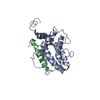
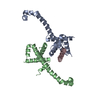


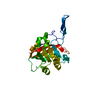




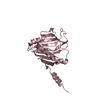
 PDBj
PDBj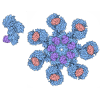
 HSQC
HSQC